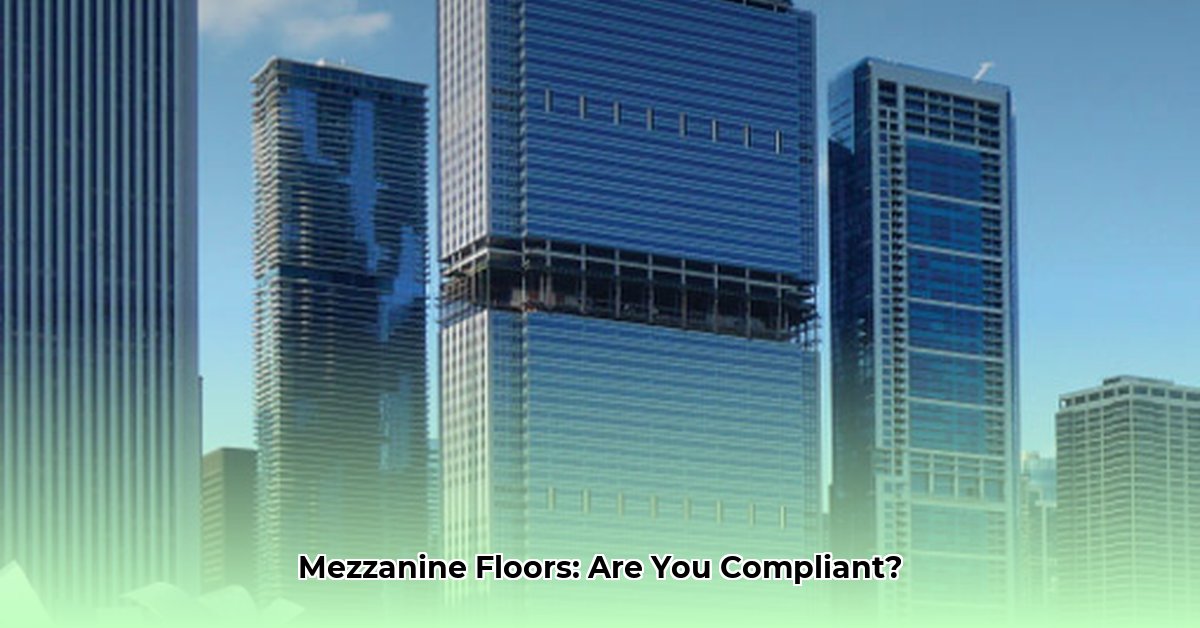Thinking about adding a mezzanine floor? It sounds great, but dealing with all those building rules and regulations can be a real headache. This guide cuts through the confusion and shows you exactly how to make sure your mezzanine project is safe, compliant, and functional. For more design standards, see this helpful guide on mezzanine floor design. Let’s get started!
Understanding Mezzanine Floor Regulations: A Comprehensive Guide
Building a mezzanine? It’s exciting, but let’s ensure we do it right from the start. This comprehensive guide will walk you through the essential building regulations for mezzanine floors, helping you avoid costly mistakes and create a safe, compliant, and functional space. Consider this your detailed blueprint for a successful project.
Decoding the Rules: Key Regulatory Bodies
Several sets of regulations will impact your mezzanine project. The primary ones are typically your local building codes (often based on the International Building Code or IBC), which establish fundamental construction standards. OSHA (Occupational Safety and Health Administration) regulations focus heavily on worker safety during construction and the subsequent use of the mezzanine space. Finally, your local authorities have the ultimate say, often adding specific amendments and requirements to the mix. It’s a crucial trifecta – meeting all three will ensure project success. Ignoring local building codes can lead to significant fines, project delays, and even legal action.
Structural Soundness: Engineering and Design Principles
A safe mezzanine begins with a robust and thoroughly vetted design. Engage a qualified structural engineer – they possess the expertise to ensure your design adequately handles the anticipated loads and stresses of daily use, as well as any unforeseen events. The structural engineer will calculate the maximum load-bearing capacity of your mezzanine, ensuring it’s built to withstand that weight, while also considering factors like seismic activity (earthquakes) or high wind loads if applicable to your geographical location. Verifying your building’s existing load-bearing capacity is paramount to safely implement a new mezzanine structure.
Fire Safety Imperatives: Safeguarding Life and Property
Fire safety is not only important, it’s paramount. Building regulations invariably mandate the use of specific fire-resistant materials to protect occupants and minimize property damage. This may involve the use of fire-retardant-treated lumber, specialized types of fire-rated drywall, or other approved materials. Depending on the specific size, intended use of your mezzanine, and prevailing local regulations, you might be required to install a comprehensive fire suppression system, including sprinklers, smoke detectors, and fire alarms. Clearly designated and accessible emergency escape routes are also a mandatory requirement. Consider all aspects of fire protection and suppression when designing your mezzanine.
Egress Essentials: Planning for Safe Evacuation
Clearly defined and easily accessible escape routes are absolutely non-negotiable in any building, and mezzanines are no exception. Regulations dictate the provision of safe and unobstructed paths for occupants to evacuate the mezzanine in the event of an emergency. These egress routes typically include stairways, ramps, or a combination thereof. Strict regulations govern the required width of these escape routes, the maximum allowable riser height and tread depth for stairs, and the specifications for handrails. Properly planned and constructed egress routes are critical to occupant safety.
OSHA Guidelines: Prioritizing Worker Safety
OSHA plays a vital role in ensuring worker safety, both during the mezzanine construction phase and during its subsequent use. This includes implementing adequate guardrails around open edges, the potential use of safety nets, and adherence to other fall protection measures. Failure to comply with OSHA regulations can lead to serious worker injuries and substantial financial penalties. A comprehensive fall protection plan is essential to meet OSHA’s safety standards.
Navigating Local Ordinances: Understanding Unique Requirements for Construction Projects
Keep in mind that building codes can vary significantly from one jurisdiction to another. Always consult directly with your local building department to ascertain the specific regulatory requirements applicable to your project. They can provide invaluable guidance regarding specific requirements for materials, construction methods, permitting processes, and inspection protocols. Proactive engagement with your local building department will ensure a smoother and more compliant project.
Planning Permission Protocols: Determining When Additional Approvals are Required
Depending on the scope and nature of your mezzanine project, and particularly if it involves significant structural alterations to the existing building, you may be required to obtain additional planning permission from your local authorities. This is particularly relevant for larger projects, those situated in historically sensitive areas, or those that may impact the external appearance of the building. Determine early in the process whether extra planning permission is needed for construction.
Documentation and Record-Keeping: Maintaining Accurate Project Records
Maintain meticulous and detailed records throughout every stage of the mezzanine project. Comprehensive documentation is essential for facilitating inspections and demonstrating compliance with all applicable regulations. This documentation should include design drawings, material specifications, inspection reports, and any other relevant project-related correspondence. Accurate and organized records are crucial for demonstrating regulatory compliance.
Step-by-Step Guide: Achieving Mezzanine Compliance
Here’s a step-by-step checklist:
- Research Local Regulations: Conduct thorough research to fully understand the specific building regulations pertaining to mezzanine floors in your local area.
- Engage Qualified Professionals: Retain the services of a qualified structural engineer and a licensed architect who possess demonstrable experience with mezzanine projects.
- Design with Precision: Develop comprehensive and meticulously detailed plans that address all relevant aspects, including structural integrity, fire safety, and means of egress.
- Secure Necessary Permits: Obtain all required permits and approvals from your local building department before commencing any construction activities.
- Construct with Diligence: Adhere strictly to the approved plans and comply with all applicable codes and regulations during the construction phase.
- Schedule Inspections: Proactively schedule inspections at various stages of the construction process, as required by your local building department.
- Maintain Comprehensive Records: Meticulously document every stage of the design, construction, and inspection processes.
- Implement a Maintenance Program: Establish a regular maintenance schedule to ensure the ongoing safety and functionality of the mezzanine, including periodic inspections of fall protection equipment.
By following these steps, you can maximize your chances of building a safe, compliant, and functional mezzanine that meets all applicable regulatory requirements.
Planning Permission for Large Mezzanine Floor Installations
Building regulations approval is mandatory for all mezzanine installations. But what size triggers the need for planning permission?
Key Takeaways:
- Building regulations approval remains mandatory for all mezzanine installations, regardless of size.
- Planning permission may be required for larger mezzanine structures, typically those exceeding a certain square footage (often 200m²). However, this threshold can vary significantly depending on local regulations.
- Fire safety is of paramount importance, necessitating the use of fire-resistant materials and clearly defined escape routes that comply with all applicable building codes.
- Structural integrity is essential, requiring adherence to relevant British Standards (BS) and all applicable safety regulations.
- Successfully navigating the complex regulatory landscape requires careful planning, professional expertise, and strict adherence to all applicable codes and regulations.
Unraveling the Regulatory Web
Constructing a mezzanine floor, particularly one of substantial size, involves more than just physical construction. It requires a thorough understanding of the complex web of regulations that govern such projects. This means understanding the distinctions between building regulations and planning permission. Building regulations are universally applicable; they address safety, structural soundness, and fire protection. Planning permission, on the other hand, is typically required only for larger installations or those that may have a significant impact on the surrounding environment. The precise size threshold that triggers the need for planning permission remains a gray area, with figures ranging from 50m² to 200m² commonly cited.
Determining the Need for Planning Permission
So, how do you determine if your large mezzanine floor installation requires planning permission? Instead of relying solely on potentially ambiguous square footage thresholds, consider the following factors:
- Size Relative to Existing Structure: Is the proposed mezzanine significantly large in comparison to the overall size of the existing building?
- Impact on External Appearance: Will the construction of the mezzanine noticeably alter the building’s external appearance or character?
- Intended Use: The intended use of the mezzanine can influence the need for planning permission. Certain uses may be subject to more stringent regulations.
- Location and Local Policies: The building’s location and the specific planning policies of the local authority can have a significant impact on the requirements. Buildings located in conservation areas or areas of outstanding natural beauty may be subject to stricter regulations.
Engage in a pre-application discussion with your local planning authority. Even a minor delay due to initial consultation is preferable to a major hold-up mid-construction.
Navigating the Building Regulations Approval Process
Regardless of whether or not planning permission is required, securing building regulations approval is absolutely mandatory for all mezzanine projects. This process involves submitting detailed plans and specifications to your local authority’s building control department. These plans must comprehensively demonstrate compliance with all applicable building regulations. Key elements that must be addressed in your submission include:
1. Structural Design: The plans must provide detailed information demonstrating that the mezzanine is structurally sound and capable of supporting the anticipated loads.
2. Fire Safety Measures: The plans must clearly detail all fire safety features, including fire-resistant materials, fire suppression systems, and emergency escape routes.
3. Accessibility Considerations: If the mezzanine is intended to be accessible to the public or employees, the design must adhere to all applicable accessibility standards, ensuring that it is usable by people with disabilities.
4. Compliance with British Standards: Ensuring that your design and construction adhere to all relevant British Standards is crucial for demonstrating compliance.
5. Submission and Approval: Submit your plans and all supporting documentation to your local authority building control department for review and approval.
- Glass Tile Shower Ideas to Create a Stunning Bathroom Space - December 7, 2025
- Glass Wall Tile Ideas for Kitchens and Bathrooms - December 6, 2025
- Glass Tile Bathroom: Create a Beautiful, Easy-Clean Space - December 5, 2025










